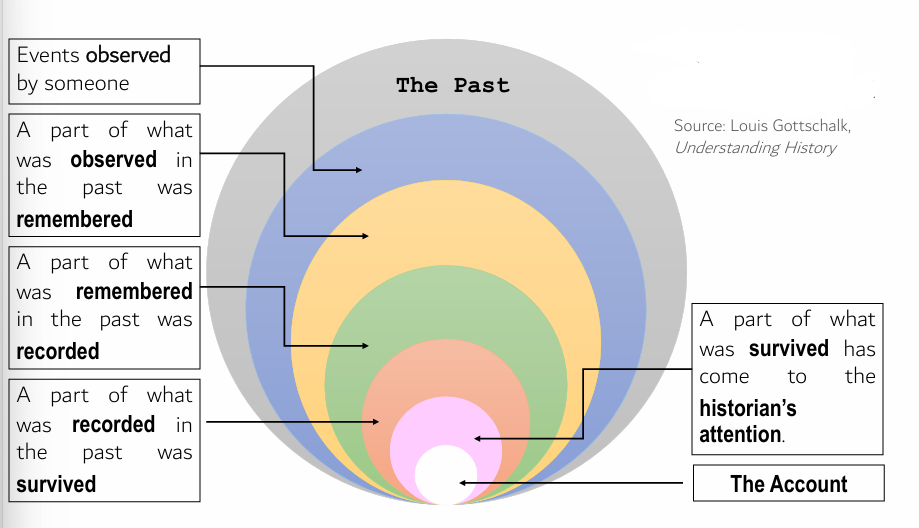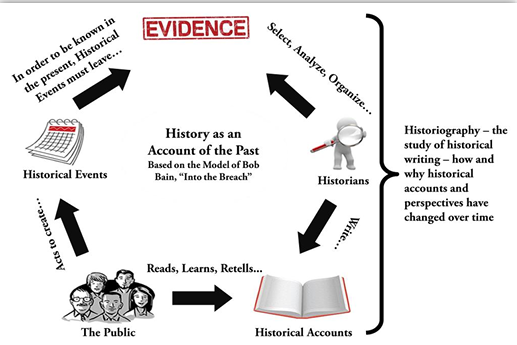Lesson 2: Historical Method and Primary Sources
1/25
There's no tags or description
Looks like no tags are added yet.
Name | Mastery | Learn | Test | Matching | Spaced |
|---|
No study sessions yet.
26 Terms
HISTORY AS RECONSTRUCTION
The Past
Events observed by someone.
A part of what was observed in the past was remembered.
A part of what was remembered in the past was recorded.
A part of what was recorded in the past was survived.
A part of what was survived has come to the historian’s attention.
The Account

HISTORIOGRAPHY
The study of the various approaches to historical method, the actual writing of history, and primarily, the various interpretations of historical event.

SCHOOL OF THOUGHT
Accidentalist
Historicist
Structuralist
Annales School
Intentionalist
Marxist
Hegelian
Post Modernist
ACCIDENTALIST
A school of thought that subscribes to the idea that behind every historical event are accidents which served as driving force. The focus is more on why the event happened.
Examples:
Magellan’s accidental rediscovery of the Philippines during the First Voyage Around the World.
A mosquito bite prevented Trotsky being fit enough to seize control of the USSR.
HISTORICIST
A school of thought with a scientific approach to history pioneered by von Ranke. Based on the objective study of primary sources. Believed that the study of such sources would allow a reconstruction of history “wie es eigentlich gewesen ist” — as it actually was.
Example:
Method in Creating History (Positivism)
The Positivists rely on the use of sources for accurate and complete visualization of the past.
STRUCTURALIST
A school of thought that believes in the role of political and military structures in shaping history. This school of historiography emphasize that historical events happened due to the existing political and military structures.
Example:
City States of Italian Renaissance
Absence of Church allowed Renaissance to flourish
ANNALES SCHOOL
A school of thought that promoted a new form of history by studying the lives of ordinary people and inquiries into climate, demography, agriculture, commerce, technology, transportation, and communication, as well as social groups and mentalities.
Trivia:
Named after the journal Annales of Economic and Social History
INTENTIONALIST
The school recognizes the roles played by key individuals in history as they were influenced by their intentions and personalities thus, they acted on a particular circumstance which led to the unfolding of history.
Example:
Hitler’s master plan created and caused the Holocaust.
MARXIST
Economic forces are the main driving force in historical change. Karl Marx relied heavily upon statistical data to show that exploitation and class conflict drove history in this school of thought.
Example:
Studies of the Peasant’s Revolt which focus on prices of bread and declining wages.
American Revolution
HEGELIAN
Intellectual movements and the progress of ideas are the driving forces in historical change according to this school of thought. Hegel viewed history as a relentless advancement towards freedom. Studies of ideas such as the Renaissance are often Hegelian in character.
POST MODERNIST
As a school of historiography, this is strongly influenced by Foucault when he disputed that all sources are biased, incomplete, and language itself has no fixed meaning, therefore the past cannot be known. It also subscribes to the belief that all interpretations of history are valid.
HISTORICAL METHOD
Refers to the use of primary historical data to answer a question.
The process of critically examining and analyzing the records and survivals of the past. (Louis Gottschalk, Understanding History)
HISTORICAL CRITICISM
Also known as the evaluation of documents.
Aims:
Find out whether a document or idea is acceptable as authentic or not.
Eliminate errors and to know the truth.
In order for a source to be used as evidence in history, basic matters about its form and content must be settled.
EXTERNAL CRITICISM
Authenticates evidence and establishes texts in the most accurate possible form.
Lower Criticism and Test of Authenticity
Determine the date of the document to see whether they are anachronistic.
Determine the author.
Anachronistic style
Anachronistic reference to events
Provenance or custody
Semantics - determining the meaning of a text or word
Hermeneutics - determining ambiguities
Checklist:
Who wrote the document?
For what purpose was the document written?
When was the document written?
Where was the document written?
Under what conditions was the document written?
INTERNAL CRITICISM
Evaluate the accuracy and worth of the data contained therein.
Higher Criticism and Test of Credibility
Verisimilar - as close as what really happened from a critical examination of best available sources.
Identification of the author
Determination of the approximate date
Ability to tell the truth
Willingness to tell the truth
Corroboration
(Louis Gottschalk, Understanding History)
Checklist:
Is the real meaning of the statement different from its literal meaning?
How did the author report?
What was the intention of the author in reporting?
Are there inner contradiction in the document?
Does the document contain bias of any sort?
HISTORICAL SOURCES
An object from the past or testimony concerning the past on which historians depend in order to create their own depiction of that past. (Howell and Prevenier, From Reliable Sources and Introduction to Historical Method)
Tangible remains of the past. (Anthony Brundage, Going to Sources)
Written Sources
Non Written Sources
WRITTEN SOURCES
Published materials
Books, magazines, journals
Travelogue
Transcription of speech
Manuscript [any handwritten or typed record that has not been printed]
Archival materials
Memoirs, diary
NON WRITTEN SOURCES
Oral history
Artifacts
Ceramics, tools, metal objects (coins, personal adornment)
Ruins
Fossils
Artworks
Media recordings
Audio and video
PRIMARY SOURCE
Are contemporary accounts of an event, written by someone who experienced or witnessed the event in question.
Examples:
Autobiography, Diary, Memoirs
Letters, Speeches, Manuscripts
Artifacts
Photographs, Posters
Audio or video recordings
Four Main Categories:
Written sources
Images
Artifacts
Oral testimony
SECONDARY SOURCE
Describe, discuss, interpret, comment upon, analyze, evaluate, summarize, and process primary sources.
Examples:
Biographical works
Magazine and News articles
Literature reviews
Textbooks
Commentaries
REPOSITORIES OF PRIMARY SOURCES
Archives
Library
Historical Society
Museum
Special Collection
ARCHIVES
(Repository) The documentary by-product of human activity retained for their long-term value.
Records can come in a wide range of formats including written, photographic, moving image, sound, digital, and analogue.
Example: Pambansang Sinupunan ng Pilipinas (National Archives of the Philippines)
LIBRARY
(Repository) A collection or group of collections of books and/or other print or nonprint materials organized and maintained for use.
Examples:
Bicol University Library
Pambansang Aklatan ng Pilipinas (National Library of the Philippines)
HISTORICAL SOCIETY
(Repository) An organization that seeks to preserve and promote interest in the history of a region, a period, or a subject.
Example: Kapisanang Pangkasaysayan ng Pilipinas (Philippine Historical Association)
MUSEUM
(Repository) A non-profit, permanent institution in the service of society and its development, open to the public, which acquires, conserves, researches, communicates, and exhibits the tangible and intangible heritage of humanity and its environment for the purposes of education, study, and enjoyment.
Example: Pambansang Museo ng Pilipinas (National Museum of the Philippines)
SPECIAL COLLECTION
(Repository) Library and archival materials in any format (e.g. rare books, manuscripts, photographs, institutional archives) that are generally characterized by their artifactual or monetary value, physical format, uniqueness or rarity, and/or an institutional commitment to long-term preservation and access (King, 2018).
Items are fragile, rare, and valuable.
Example: Albert and Shirley Small Special Collection at University of Virginia